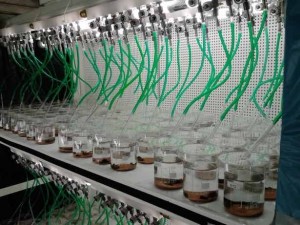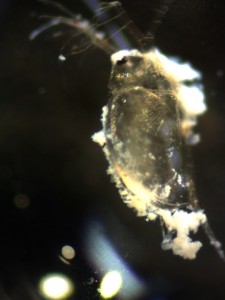In this new series of posts, research teams/groups of Landau’s Institute of Environmental Sciences introduce their Ecotoxicology-related research. This time: the team “Functional Aquatic Ecotoxicology”
The Research Team “Functional Aquatic Ecotoxicology”, which is led by Ass.-Prof. Dr. Mirco Bundschuh, has three major research pillars, which may be represented by the following research questions:
- What are the mechanisms explaining the impact of stressors in aquatic heterotrophic food webs and the ecosystem processes they provide? Currently, we are working on several projects adressing this issue, for instance dealing with the effects of insecticides, fungicides, or antimicrobial substances in general.
- What is the role of emerging chemical stressors (currently mainly nanoparticles) in aquatic ecosystems and how is this role modified by environmental conditions? In this context, we are for example responsible for the INTERNANO sub-project IMPACT.
- Can we take advantage of low- but also high-tech methods to reduce the impact of contaminants from point and diffuse sources?
To adequately address these questions we are working on various levels of biological organization: The responses on the level of subcellular stress responses as well as the enzymatic activities support the interpretation of effects observed for individual organisms as well as microbial communities. At the same time, the energy reserves and thus the composition of amino and fatty acids of individuals may determine their general fitness and thus their ability to maintain their somatic or population growth but also their interaction with other members of the food web. With this information, we believe being able to explain also shifts in the functions we observe under controlled laboratory but also field conditions in response to anthropogenically induced stress.
This approach requires working with experimental systems ranging from small beaker glass over artificial laboratory or semi-field stream channels to field approaches. Thereby the replication usually decreases with increasing level of complexity while the field relevance and thus the transferability to the field are increasing. The Research Team also takes advantage of a variety of approaches including nanoparticle specific analyses, molecular biological analyses, and analytical tools helping to characterize the physiological fitness of, the uptake of chemical stressors by the organisms as well as to verify the exposure concentrations. This multidimensional approach opens opportunities for involving students during their theses but also for collaborations with national and international experts in their field.
People: Ass.-Prof. Dr. Mirco Bundschuh, Patrick Baudy, Dominic Englert, Marco Konschak, Simon Lüderwald, Kymberly Newton, Dr. Ricki R. Rosenfeldt, Theresa Schell, Dr. Frank Seitz, Jochen P. Zubrod, Alexander Feckler (associated)
Recent publications:
Zubrod, J.P., Englert, D., Feckler, A., Koksharova, N., Konschak, M., Bundschuh, R., Schnetzer, N., Englert, K., Schulz, R., Bundschuh M. 2015: Does the current fungicide risk assessment provide sufficient protection for key drivers in aquatic ecosystem functioning? Environmental Science & Technology, 49, 1173-1181.
Rosenfeldt, R.R., Seitz, F., Senn, L., Schulz, R., Bundschuh, M. 2015: Nanosized titanium dioxide reduces copper toxicity – the role of organic material and the crystalline phase. Environmental Science & Technology, 49, 1815-1822.
Kalčíková, G., Englert, D., Rosenfeldt, R.R., Seitz, F., Schulz, R., Bundschuh, M. 2014: Combined effect of UV-irradiation and TiO2-nanoparticles on the predator-prey interaction of gammarids and mayfly nymphs. Environmental Pollution 186, 136-140.
Bundschuh, M., Schulz, R., 2011: Ozonation of secondary treated wastewater reduces ecotoxicity to Gammarus fossarum (Crustacea; Amphipoda): are loads of (micro)pollutants responsible? Water Research 45(13) 3999-4007.
Englert, D., Zubrod, J.P., Schulz, R., Bundschuh, M. 2013: Effects of municipal wastewater on aquatic ecosystem structure and function in the receiving stream. Science of the Total Environment 454-455, 401-410.
For more info, see our team homepage!




